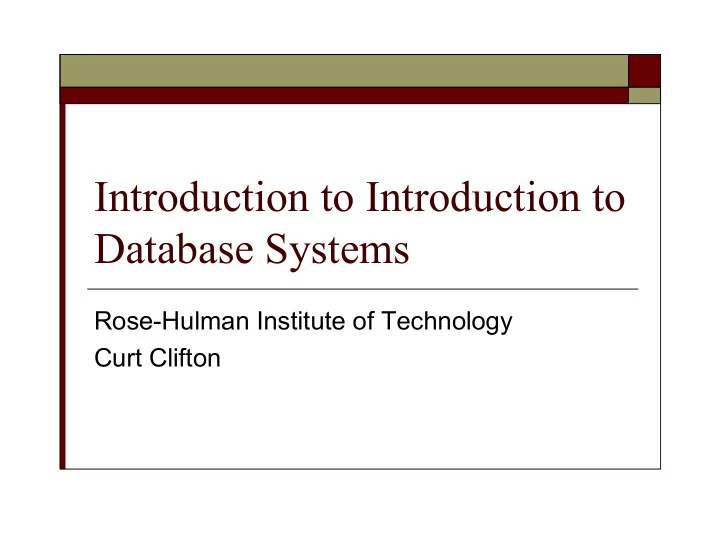

Introduction to Introduction to Database Systems Rose-Hulman Institute of Technology Curt Clifton
Role Call Please… Correct my mispronunciations Let me know your preferred name
Introductions Name Major Hometown An interesting fact about you that others at Rose probably don’t know
Course Overview Materials on Angel Most also on web and AFS: www.rose-hulman.edu/Class/csse/csse333 Test-first teaching Syllabus Schedule
What databases do you interact with in a typical week?
Types of Databases Traditional (numeric, textual) Multimedia Geographic Information Systems Data Warehouses Active Databases
Database: A Collection of Data with Three Properties Abstraction of “real world” Logically coherent Designed to fulfill a purpose
Some Other Terms Data Known facts with implicit meaning Mini-world Part of “real” world about which data is stored DBMS or Database Management System Software system for creating/maintaining a computerized database Database System DBMS + data + applications
DBMS Must Allow Definition of data types, structures, constraints Construction of database on physical media Manipulation to answer queries and add, delete, or modify data Concurrent access for multiple users Secure access to sensitive data Active processing in response to data changes
Database System Architecture
Running Example: University DB Entities The things that the database tracks Relationships How the entities go together
Sample University Data Typically a table for each kind of entity Rows represent entities Columns represent attributes Example… STUDENT Name Number Class Major Smith 6152 2006 CS Jones 8941 2007 CS
Views Ways of looking at data Not necessarily stored in actual tables
Why use databases at all?
Database Stakeholders Workers behind the scenes Workers on the scene End Users Other stakeholders
Workers Behind the Scenes DBMS designers Tool developers
Workers on the Scene DBAs—Database Administrators Control access Monitor use Acquire resources Monitor efficiency Database Designers Communicate with end users Define content, structure, and constraints on data
End Users (1/2) Casual end users Occasional access as needed Naïve (or parametric) end users Use “canned transactions” E.g, bank teller, airline desk agent Typically majority of database use is by naïve end users
End Users (2/2) Sophisticated End Users Write custom queries against database E.g., business analysts, scientists, engineers Stand-alone End Users Maintain personal databases using COTS packages E.g., iTunes, TurboTax
Database Advantages Are Self-describing Provide Program-Data Independence Require Data Abstraction Show Multiple Views Allow Multi-user Data Sharing
Other Database Advantages Control of redundancy Referential integrity Security enforcement Deductive capability Persistence Standards enforcement Efficient data retrieval Fast application development Robustness Flexibility Representation of complex relationships Concurrency management Data integrity Economies of scale
Database Disadvantages Significant initial financial investment Can increase system overhead Limit rapid prototyping Don’t handle rapid changes in data collected Require support resources
Don’t Use a Database When System… Has no need for persistence Is computationally, not data, intensive Has a single user and simple data Uses very static data
Recommend
More recommend